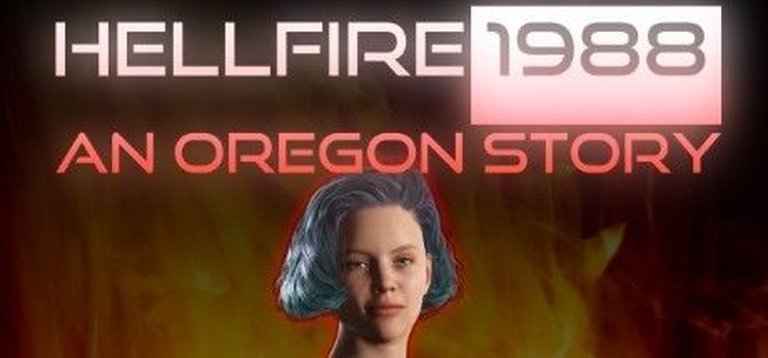- Release Year: 2022
- Platforms: Windows
- Publisher: Mama Makes Games, LLC
- Developer: Mama Makes Games, LLC
- Genre: Adventure
- Perspective: 3rd-person
- Game Mode: Single-player
- Gameplay: Graphic adventure, Puzzle elements, Visual novel
- Setting: 1980s, North America
- Average Score: 100/100

Description
Hellfire 1988: An Oregon Story is a story-rich visual novel set in Bend, Oregon, during Halloween 1988, following Jennifer Craft, a seventeen-year-old slacker, as she becomes entangled in a darkly comedic crime drama. Blending point-and-click adventure gameplay with interactive dialogue, challenging puzzles, and mini-games, the game immerses players in a 30,000-word narrative filled with realistic choices, trenchant humor, and a hard rock soundtrack. Set against the backdrop of 1980s America, infused with noir, psychedelic, and Cold War undertones, this Unreal Engine 5-powered indie title delivers a compelling, emotionally charged experience with a playtime of 2 to 4 hours.
Gameplay Videos
Where to Buy Hellfire 1988: An Oregon Story
PC
Hellfire 1988: An Oregon Story Patches & Updates
Hellfire 1988: An Oregon Story Mods
Hellfire 1988: An Oregon Story Guides & Walkthroughs
Hellfire 1988: An Oregon Story: A Haunting Ode to Small-Town Mysteries and Moral Ambiguity
Introduction
In an industry dominated by blockbuster budgets and open-world sprawl, Hellfire 1988: An Oregon Story (2022) boldly stakes its claim as a narrative-focused indie gem. Blending visual novel introspection with point-and-click puzzle-solving, this gritty tale of teenage rebellion and small-town prejudice delivers a tightly wound, 2–4 hour experience that lingers like a fog over the Pacific Northwest. While its technical ambitions occasionally falter, the game’s uncompromising vision—coupled with its charitable ethos—cements its place as a compassionate, if imperfect, love letter to 1980s Americana.
Development History & Context
Developed by Mama Makes Games, LLC (MMG Company), Hellfire 1988 represents a daring fusion of retro nostalgia and cutting-edge technology. The studio’s decision to build a narrative-driven indie title in Unreal Engine 5—a toolkit more synonymous with AAA action games—speaks to its ambition. Released in May 2022, the game arrived during a renaissance of retro-themed storytelling, with titles like Norco and Kathy Rain redefining pixel-art nostalgia. Yet Hellfire 1988 diverges by embracing 3D environments and comic-book-styled visuals, leveraging UE5’s lighting capabilities to evoke the moody, rain-soaked streets of Bend, Oregon.
The project’s humanitarian angle is equally noteworthy: 100% of net proceeds support the Bend Fire Community Assistance Program, a charity aiding families in crisis. This philanthropic underpinning aligns with the game’s themes of communal prejudice and resilience, blurring the lines between art and activism.
Narrative & Thematic Deep Dive
At its core, Hellfire 1988 is a coming-of-age thriller fueled by moral ambiguity. Players inhabit Jennifer Craft, a 17-year-old metalhead ostracized by Bend’s conservative logging community. When a local crime implicates her, Jennifer must navigate a labyrinth of suspicion, family secrets, and societal judgment. The script—30,000 words of branching dialogue—excels in capturing the tension between counterculture rebellion and small-town claustrophobia.
Themes of otherness permeate every interaction. Jennifer’s love of hard rock and disdain for conformity make her an easy scapegoat, echoing real-world struggles of marginalized youth. Dialogues with townsfolk oscillate between dark humor (“Your music’s gonna summon the Devil, kid”) and poignant vulnerability, particularly in scenes with her estranged father, a Vietnam vet grappling with addiction. The narrative’s boldest stroke lies in its refusal to sanitize its subject matter: drug use, systemic bias, and class divides are addressed with unflinching sincerity.
Gameplay Mechanics & Systems
Hellfire 1988 merges visual novel decision-making with point-and-click exploration, though the balance leans heavily toward the former. Choices range from innocuous (selecting a mixtape track) to morally fraught (lying to protect a friend), with multiple endings reflecting Jennifer’s alliances and self-perception.
The puzzle design is serviceable but uneven. Mini-games, such as hacking a payphone or deciphering a cryptic poem, are inventive yet occasionally marred by clunky controls. Post-launch patches introduced a “visual novel-only” mode, stripping puzzles for narrative purists—a smart concession to accessibility. The UI, however, remains a weak point: early versions faced criticism for cursor visibility and save-menu awkwardness, though updates rectified these issues.
World-Building, Art & Sound
Bend, Oregon, is as much a character as Jennifer. UE5’s capabilities render the town in moody blues and ochres, with flickering neon signs and vinyl-covered diner booths evoking a timeless 1980s aesthetic. The comic-book art style—think Daniel Clowes meets Twin Peaks—lends a surreal edge to otherwise grounded locales, such as a graffiti-strewn trailer park or a fog-drenched forest.
The hard rock soundtrack is a standout, blending sleazy riffs and synthwave beats to mirror Jennifer’s defiance. Notably, the game avoids licensed tracks, instead crafting an original score that feels both era-appropriate and thematically cohesive. Environmental sounds—the creak of porch swings, distant train whistles—deepen the immersion, though occasional audio mixing issues disrupt the atmosphere.
Reception & Legacy
At launch, Hellfire 1988 garnered a 100% positive rating from Steam users (15 reviews), praised for its writing and emotional resonance. Critics remain silent, but its grassroots appeal lies in its nuanced portrayal of adolescence and charitable mission. The decision to donate proceeds to Bend’s community program has bolstered its reputation as a socially conscious work, though some players criticized its short runtime and technical hiccups.
Its legacy may hinge on its pioneering use of UE5 for indie narratives. While not visually groundbreaking, it demonstrates the engine’s flexibility beyond action genres. Future titles could draw inspiration from its thematic boldness and hybrid design, even as its own flaws highlight the challenges of marrying cinematic ambition with indie-scale resources.
Conclusion
Hellfire 1988: An Oregon Story is a defiant, deeply human experiment. Its razor-sharp writing and atmospheric world-building compensate for rough technical edges, while its philanthropic mission adds moral weight to Jennifer’s journey. Though unlikely to dethrone genre titans like Disco Elysium, it carves a niche as a cathartic snapshot of 1980s alienation—a reminder that even the smallest towns harbor the loudest rebellions. For narrative adventurers willing to forgive its stumbles, this is a campfire tale worth gathering around.